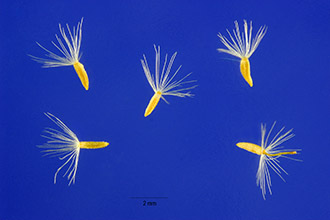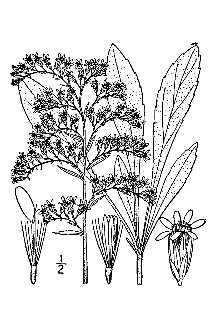Gray Goldenrod
Scientific Name: Solidago nemoralis Aiton

| General Information | |
|---|---|
| Usda Symbol | SONE |
| Group | Dicot |
| Life Cycle | Perennial |
| Growth Habits | Forb/herb |
| Native Locations | SONE |
Plant Guide
Use soil moisture sensors to measure the soil moisture of Gray Goldenrod.
Fact Sheet
Alternate Names
Old Field Goldenrod, Prairie Goldenrod, Dwarf Goldenrod , Use soil moisture sensors to measure the soil moisture of Gray Goldenrod.
Uses
Status
Please consult the PLANTS Web site and your State Department of Natural Resources for this plant’s current status (e.g. threatened or endangered species, state noxious status, and wetland indicator values).
Description and Adaptation
Adaptation
Adaptation
Gray goldenrod is a native perennial wildflower it is one of the smaller species of goldenrod, growing from 6 inches and seldom reaching 2.5 feet tall. The central stem is reddish or grey-green and covered with short white hairs, often in lines. Usually this stem has winged leaflets at the axils of the upper leaves. The alternate leaves are up to 4 inches long and ¾” across, pubescent (covered with fine short hairs) and become smaller as they ascend the stem. The leaves taper to a narrow base and have a soft scratch feel to them. The leaf margins are smooth or slightly serrate. Grey goldenrod flowers later than most other goldenrods. The narrow flower is wider in the middle and has numerous yellow compound flowers that are about ¼” across. The blooming period occurs during the fall and lasts about a month. The flowers occasionally have a slight fragrance. After flowering, the small dry seed develops with tufts of hair and are dispersed by the wind. The root system consists of a branching caudex (a thickened root structure that serves as water storage for the plant) and rhizomes. The caudex root system is especially prevalent on older plants. In suitable locations, grey goldenrod has a tendency to form groups of plants. Grey goldenrod is a carefree plant that prefers growing in full sun and dry soil. This plant thrives in sand, clay or gravel soils. It will also grow in fertile soils however it can be short-lived if the site is too rich. Distribution: This species is widely distributed from Georgia to Texas, north to Nova Scotia and Alberta Canada in USDA cold hardiness zones 2 – 9. Habitats include: meadows, dry open woods, upland prairies, pastures, savannas, fallow fields, thickets, roadsides, railroads, eroded slopes, and sand dunes
Establishment
Seed Propagation: Seed ripens in the autumn and should be collected when the heads are brown and become fluffy. Fresh seed germinates at low percentages without any pretreatment. Germination is improved by 90 days of cold moist pretreatment (40 degrees F). This pretreatment may be accomplished artificially in a refrigerator or by sowing the seed in the fall. Vegetative Propagation: Four to six node softwood stem cuttings taken in the late spring root nearly 100 percent. Plants may also be propagated by division of mature plants. Make sure each section has a bud and a root. It can also be divided by separating individual crowns with a length of rhizome (horizontal plant stem with shoots above and roots below) before growth begins in the spring.
Management
Grey goldenrod is a hardy, pioneer plant with relatively few problems. It is easy to maintain with the addition of low to moderate levels of nitrogen (50 lbs. / acre). Before amending the soil with any additional nutrients a soil test is highly recommended. Gray goldenrod will naturalize under optimal conditions and can become weedy in moist, highly fertile soils, especially in the Western U.S.
Pests and Potential Problems
Gray goldenrod tends to be a care-free plant but may be affected by spot anthracnose, powdery mildew, rust, and fungal spots in moist conditions.
Environmental Concerns
Weediness: This plant may become weedy or invasive in western states where it may displace other desirable vegetation if not properly managed.
Plant Traits
Growth Requirements
| Temperature, Minimum (°F) | -33 |
|---|---|
| Adapted to Coarse Textured Soils | Yes |
| Adapted to Fine Textured Soils | No |
| Adapted to Medium Textured Soils | Yes |
| Anaerobic Tolerance | None |
| CaCO3 Tolerance | Medium |
| Cold Stratification Required | No |
| Drought Tolerance | Medium |
| Fertility Requirement | Low |
| Fire Tolerance | High |
| Frost Free Days, Minimum | 150 |
| Hedge Tolerance | High |
| Moisture Use | Medium |
| pH, Maximum | 7.5 |
| pH, Minimum | 6.5 |
| Planting Density per Acre, Maxim | 11000 |
| Planting Density per Acre, Minim | 2700 |
| Precipitation, Maximum | 45 |
| Precipitation, Minimum | 15 |
| Root Depth, Minimum (inches) | 12 |
| Salinity Tolerance | None |
| Shade Tolerance | Intolerant |
Morphology/Physiology
| After Harvest Regrowth Rate | Rapid |
|---|---|
| Toxicity | None |
| Resprout Ability | No |
| Shape and Orientation | Decumbent |
| Active Growth Period | Spring and Summer |
| Bloat | None |
| C:N Ratio | Medium |
| Coppice Potential | No |
| Fall Conspicuous | No |
| Fire Resistant | No |
| Flower Color | Yellow |
| Flower Conspicuous | Yes |
| Foliage Color | Green |
| Foliage Porosity Summer | Moderate |
| Foliage Porosity Winter | Porous |
| Fruit/Seed Color | Brown |
| Nitrogen Fixation | None |
| Low Growing Grass | No |
| Lifespan | Short |
| Leaf Retention | No |
| Known Allelopath | No |
| Height, Mature (feet) | 2.0 |
| Growth Rate | Rapid |
| Growth Form | Rhizomatous |
| Fruit/Seed Conspicuous | No |
| Foliage Texture | Medium |
Reproduction
| Vegetative Spread Rate | Rapid |
|---|---|
| Small Grain | No |
| Seedling Vigor | High |
| Seed Spread Rate | Rapid |
| Fruit/Seed Period End | Fall |
| Seed per Pound | 1008000 |
| Propagated by Tubers | No |
| Propagated by Sprigs | No |
| Propagated by Sod | No |
| Propagated by Seed | Yes |
| Propagated by Corm | No |
| Propagated by Container | Yes |
| Propagated by Bulb | No |
| Propagated by Bare Root | No |
| Fruit/Seed Persistence | No |
| Fruit/Seed Period Begin | Summer |
| Fruit/Seed Abundance | High |
| Commercial Availability | No Known Source |
| Bloom Period | Summer |
| Propagated by Cuttings | Yes |
Suitability/Use
| Veneer Product | No |
|---|---|
| Pulpwood Product | No |
| Protein Potential | Medium |
| Post Product | No |
| Palatable Human | No |
| Palatable Graze Animal | Medium |
| Palatable Browse Animal | Medium |
| Nursery Stock Product | Yes |
| Naval Store Product | No |
| Lumber Product | No |
| Fodder Product | No |
| Christmas Tree Product | No |
| Berry/Nut/Seed Product | No |

